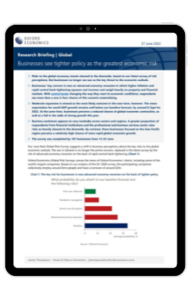Businesses see tighter policy as the greatest economic risk

Risks to the global economy remain skewed to the downside, based on our latest survey of risk perceptions. But businesses no longer see war as the key threat to the economic outlook.
Businesses’ key concern is now an advanced economy recession in which higher inflation and rapid central bank tightening squeeze real incomes and weigh heavily on property and financial markets. With central banks changing the way they react to economic conditions, respondents see more than a one in four chance of this scenario materialising.
Moderate expansion is viewed as the most likely outcome in the near term, however. The mean expectation for world GDP growth remains well below our baseline forecast, by around 0.7ppt for 2022. At the same time, businesses perceive a reduced chance of global economic contraction, as well as a fall in the odds of strong growth this year.
Business sentiment appears to vary markedly across sectors and regions. A greater proportion of respondents from financial institutions and the professional and business services sector view risks as heavily skewed to the downside. By contrast, those businesses focused on the Asia Pacific region perceive a relatively high chance of more rapid global economic growth.
The survey was completed by 167 businesses from 13-22 June
What you will learn:
-
Why most businesses report becoming more negative about global growth prospects
-
Why moderate growth is seen as most likely for 2022
- Growth expectations for 2023
Tags:
Related posts

Post
How Canada’s wildfires could affect American house prices
The Northern Hemisphere is now heading into the 2024 fire season, having just had its hottest winter on record. If it is anything like last year, we can expect to see further impacts on people, nature, and global markets.
Find Out More
Post
Major China cities face prospect of growth downshift
Over the next five years China and its major cities face the prospect of a significant downshift in economic growth. We forecast GDP to grow on average by 4.1% per year across 15 major cities in the years to 2028, down from 7.3% between 2015-2019.
Find Out More
Post
US metros to see decelerating growth in the medium term
We forecast stable GDP growth across most US metros in 2024, followed by decelerating growth over the subsequent four years. All of the top 50 metros are forecast to see real GDP growth in 2024 as well as continued but slower growth through 2028.
Find Out More